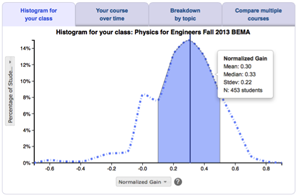SCALE-UP
Teaching materials
Types of SCALE-UP activities with examples:
- Class outline: Because lab/lecture/tutorial sections are integrated, SCALE-UP class periods are typically long (~ 2 hrs), and filled with many short activities. To help students keep track of where they are in the class, the SCALE-UP developers recommend presenting an overview of each day's class on a web page that fits on a single computer screen and can be reviewed later. Example class outline
- Tangibles: These are short activities involving physical experiments using a predict-observe-explain model. Example tangibles
- Ponderables: These are short activities involving conceptual questions that students discuss and answer. Example ponderables
- WebAssign activities: You can use WebAssign or another content management system to assign problems in class that help reinforce concepts introduced in tangibles and ponderables, and helps you quickly assess whether students are understanding the concepts. These are typically short assignments that ask questions directly related to a tangible or ponderable activity the students just did. You can keep students from completing assignments before class by putting a password on the assignment that you give them in class. Example ponderable with follow-up WebAssign activity (unit vectors)
- Labs: In addition to short tangible experiments, students in SCALE-UP classes can also do longer experimental lab work that requires a formal report. Labs allow a focus not just on conceptual understanding but also on hypothesis generation, student design of data collection, and uncertainty considerations. Example labs: capacitors and impulse
- Real World Problems: Problems like the University of Minnesota context-rich problems or the University of Maryland thinking problems are good ways to "give students challenging, realistic situations that are best analyzed by working in groups and following a problem-solving protocol" Example real world problems
- 3-way activities: Each group at a table does a different type of activity on the same topic (useful for saving money/space on equipment - you only need one set of equipment for every 9 students, and while some students use equipment that takes up a lot of table space, other students can work on a laptop). Example 3-way activity (fancart)
- Homework: Homework in SCALE-UP should be used to cover the basics that you would normally address in a lecture so that students are fully prepared to participate in group work during class. This can be achieved through assigning reading with reading quizzes and a few straightforward problems before the class on a topic. Homework can also be used to assign more challenging follow-up problems after class. You can reduce grading through online homework systems and/or a "homework lottery" where you roll a die to decide which table's homework you will grade.
Members-only SCALE-UP site:
Contact Robert Beichner for more information or to become a member. He will need to verify that you are a legitimate faculty member, so be sure to include a web link or other means of verification in your e-mail.
You can download teaching materials for SCALE-UP classes from NC State from the members-only SCALE-UP site, including:
- Intro mechanics with Matter and Interactions
- Intro E&M with Matter and Interactions
- Modern Physics
- Intro mechanics with traditional content coverage
- Intro E&M with traditional content coverage
Other sources of SCALE-UP teaching materials:
- The University of Iowa has a collection of sample materials for their TILE/SCALE-UP classes in a variety of disciplines.
- The Massachusetts Institute of Technology has complete course materials for two TEAL/SCALE-UP classes: Introductory Physics I: Mechanics and Introductory Physics II: E&M
Find more example SCALE-UP activities in the following journal articles:
- V. Kuo and R. Beichner, "Stars of the Big Dipper: A 3-D vector activity," The Physics Teacher 44 (4), 168-172 (2006). Get the activity described in the article
- M. B. Kustusch, J. D. H. Gaffney, and R. Beichner, "The Real Prize Inside: Learning about science and spectra from cereal boxes," Physics Teacher 47, 450-453 (2009). Get the activity described in the article
- J. D. H. Gaffney, E. Richards, M. B. Kustusch, L. Ding, and R. J. Beichner, "Scaling Up Education Reform," Journal of College Science Teaching 37(5), 48-53 (2008). Get the activity described in the article
Find many more research-based activities that you can use in SCALE-UP classrooms in our Expert Recommendation on finding activities for small group discussions.




